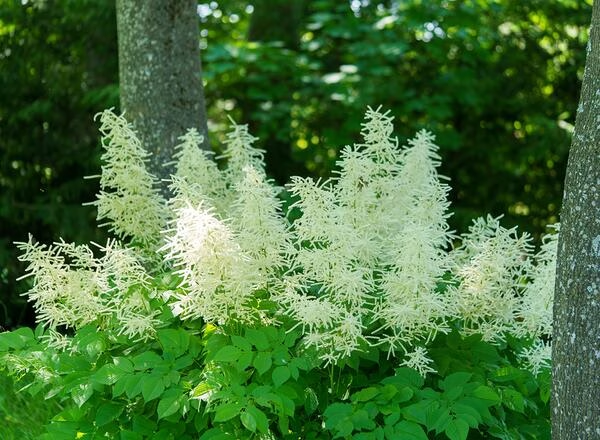
Goat’s Beard
Botanical Name
:
Aruncus dioicus
Plant Type
:
Flowering herbaceous perennial
Seasons
:
Plant in spring; Blooms in spring and summer
Sun Level
:
Full sun (at least 6 hours daily) in cooler climates; Partial shade (3–5 hours of indirect sunlight) in hot or desert regions
Ideal Soil Temperature for Planting
:
60–65°F (15–18°C)
Soil Type
:
Clay, loam, or sand, rich in organic matter
Hardiness Zones
:
4–7 (USDA)
Germination
:
Freshly harvested seeds germinate within 14–21 days when sown on the surface of a warm seedbed
P.H. Level
:
6.5–7.5
Water/Irrigation
:
Maintain consistent moisture but avoid sogginess; Water when the soil feels dry 1–2 inches deep
Fertilization
:
Add compost to the soil each spring as new growth starts
Habit
:
Clumping, shrub-like growth
Propagation
:
Division and self-seeding
Final Plant Height
:
4–6 ft
Spread
:
2–4 ft
Flowers
:
Feathery, cream-colored flower clusters (6–24 inches long) growing on spikes
Attracts
:
Butterflies and bees
Uses
:
Border plant, rain garden species, shady woodland plant, ornamental backdrop
Companions
:
Lady ferns, hostas, brunnera, and Dutchman’s pipe
Pruning
:
Remove spent flowers when the plant goes to seed to prevent spreading; Prune after flowering to encourage a bushier shape
Toxicity
:
Seeds are toxic to humans and pets
Pests
:
Generally pest-resistant, but watch for sawflies and caterpillars
Diseases
:
Root rot
Fun Fact
:
Goat’s beard is dioecious, meaning there are separate male and female plants. Male plants produce more showy, feathery flower clusters.
Additional Info
:
Mulching can help retain soil moisture and regulate temperature
Did You Know?
Often mistaken for Astilbe due to their feathery, plume-like flowers. However, goat’s beard has larger, more robust flower clusters, while Astilbe has smaller, denser blooms.
Botanical Name
:
Aruncus dioicus
Plant Type
:
Flowering herbaceous perennial
Seasons
:
Plant in spring; Blooms in spring and summer
Sun Level
:
Full sun (at least 6 hours daily) in cooler climates; Partial shade (3–5 hours of indirect sunlight) in hot or desert regions
Ideal Soil Temperature for Planting
:
60–65°F (15–18°C)
Soil Type
:
Clay, loam, or sand, rich in organic matter
Hardiness Zones
:
4–7 (USDA)
Germination
:
Freshly harvested seeds germinate within 14–21 days when sown on the surface of a warm seedbed
P.H. Level
:
6.5–7.5
Water/Irrigation
:
Maintain consistent moisture but avoid sogginess; Water when the soil feels dry 1–2 inches deep
Fertilization
:
Add compost to the soil each spring as new growth starts
Habit
:
Clumping, shrub-like growth
Propagation
:
Division and self-seeding
Final Plant Height
:
4–6 ft
Spread
:
2–4 ft
Flowers
:
Feathery, cream-colored flower clusters (6–24 inches long) growing on spikes
Attracts
:
Butterflies and bees
Uses
:
Border plant, rain garden species, shady woodland plant, ornamental backdrop
Companions
:
Lady ferns, hostas, brunnera, and Dutchman’s pipe
Pruning
:
Remove spent flowers when the plant goes to seed to prevent spreading; Prune after flowering to encourage a bushier shape
Toxicity
:
Seeds are toxic to humans and pets
Pests
:
Generally pest-resistant, but watch for sawflies and caterpillars
Diseases
:
Root rot
Fun Fact
:
Goat’s beard is dioecious, meaning there are separate male and female plants. Male plants produce more showy, feathery flower clusters.
Additional Info
:
Mulching can help retain soil moisture and regulate temperature
Did You Know?
Often mistaken for Astilbe due to their feathery, plume-like flowers. However, goat’s beard has larger, more robust flower clusters, while Astilbe has smaller, denser blooms.
Written by Nondiah Khalayi – https://www.linkedin.com/in/nondiah-khalayi/

